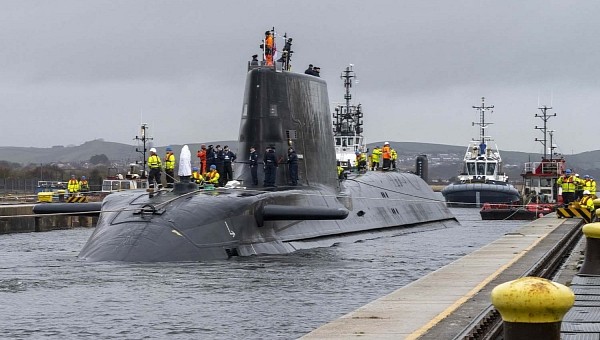Last summer, the Royal Navy was commissioning a new attack submarine, the eight vessel to ever bear the name Anson. Less than a year later, it’s getting very close to officially kicking off its first mission. Before that, it still needs to undergo sea trials at the location that will become its home - His Majesty’s Naval Base Clyde, in Scotland.
The HMS Anson will have to bear the burden of an exceptional reputation. It was introduced to the world as being not only the most powerful underwater beast to ever be built in Britain, but also the most advanced of its kind on the globe.
But at least it’s not alone. Anson is only the fifth of the new Astute class. It was preceded by HMS Astute, HMS Ambush, HMS Artful and HMS Audacious, who are already proving what they can do. And it will soon be followed by the final additions to this class, HMS Agamemnon and Agincourt, both under construction at the moment.
What makes this submarine class groundbreaking? It’s not just how technologically advanced these vessels are, but also how they were designed. According to the Royal Navy, this was done using 3D processes and computer-assisted technology. And this was a first for nuclear-powered submarines. HMS Anson is not only enormous, but also gets its prowess from two main capabilities: it can sail around the world with no refueling, while remaining stealthy and silent the entire time.
To get an idea of its stature, try to picture two Olympic swimming pools – that’s approximately how long HMS Anson is. And its massive weight goes over 8,500 tons (7,800 tonnes).
Thanks to the nuclear reactors that power it, HMS Anson will never need to be refueled throughout its expected 25 years of service. And this also helps it operate undetected, because it can cover incredibly long distances without needing to resurface. At the same time, its nuclear reactors will help supply the crew with purified air and water.
As an attack submarine, HMS Anson is also a champion in the weapon department. Not only does it carry advanced weapons, including long-range Tomahawk land attack missiles and Spearfish heavyweight torpedoes, but it can hit land-based targets that are 1,000-mile (1,600 km) away.
As impressive as HMS Anson is, something even greater is about to surpass it. The Dreadnought-Class submarines will also be nuclear-powered, but even larger, and more innovative. Compared to the 318-foot (97 meters) Astute-Class submarines, these ones will boast more than 500 feet (153 meters). Plus, they’ll be fitted with aviation-derived fly-by-wire technology.
This Class’s flagship, HMS Dreadnought, took years to build, and will be followed by three more vessels, Valiant, Warspite, and King George VI. By the end of the decade, the Royal Navy will have one of the most powerful submarine fleets in history.
But at least it’s not alone. Anson is only the fifth of the new Astute class. It was preceded by HMS Astute, HMS Ambush, HMS Artful and HMS Audacious, who are already proving what they can do. And it will soon be followed by the final additions to this class, HMS Agamemnon and Agincourt, both under construction at the moment.
What makes this submarine class groundbreaking? It’s not just how technologically advanced these vessels are, but also how they were designed. According to the Royal Navy, this was done using 3D processes and computer-assisted technology. And this was a first for nuclear-powered submarines. HMS Anson is not only enormous, but also gets its prowess from two main capabilities: it can sail around the world with no refueling, while remaining stealthy and silent the entire time.
To get an idea of its stature, try to picture two Olympic swimming pools – that’s approximately how long HMS Anson is. And its massive weight goes over 8,500 tons (7,800 tonnes).
Thanks to the nuclear reactors that power it, HMS Anson will never need to be refueled throughout its expected 25 years of service. And this also helps it operate undetected, because it can cover incredibly long distances without needing to resurface. At the same time, its nuclear reactors will help supply the crew with purified air and water.
As an attack submarine, HMS Anson is also a champion in the weapon department. Not only does it carry advanced weapons, including long-range Tomahawk land attack missiles and Spearfish heavyweight torpedoes, but it can hit land-based targets that are 1,000-mile (1,600 km) away.
As impressive as HMS Anson is, something even greater is about to surpass it. The Dreadnought-Class submarines will also be nuclear-powered, but even larger, and more innovative. Compared to the 318-foot (97 meters) Astute-Class submarines, these ones will boast more than 500 feet (153 meters). Plus, they’ll be fitted with aviation-derived fly-by-wire technology.
This Class’s flagship, HMS Dreadnought, took years to build, and will be followed by three more vessels, Valiant, Warspite, and King George VI. By the end of the decade, the Royal Navy will have one of the most powerful submarine fleets in history.









